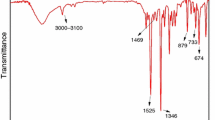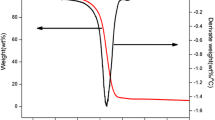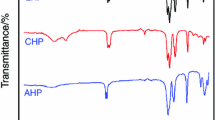Abstract
The mechanism of evaporation of Sb2O3 and the mechanism of formation and evaporation of antimony trihalides (SbX3) from Sb2O3 + halogen, which play important roles in the flame retardation of plastics, have been studied in the case of chlorine- and bromine-containing additives at different Sb/X mole ratios by means of complex thermal analysis, and massspectrometers. The temperatures of SbCl3 formation and its evaporation have been determined for PVC and Cerechlor 70 as chloride donors. The formation of SbBr3 could not be verified when Flammex (decabromodiphenyl ether) was used. A close correlation has been found between conventional and atomic absorption thermoanalytical curves recorded under identical experimental conditions. The atomic absorption detection of the thermally evolved products provides valuable information on flame retardation process.
Zusammenfassung
Der Mechanismus der Bildung und Verdampfung des bei der Brennverzögerung von Kunststoffen eine wichtige Rolle spielenden Sb2O3 und der sich aus Sb2O3 und Halogenen bildenden Antimontrihalogenide (SbX3) kann im Falle von chlor- und bromhaltigen Additiven bei unterschiedlichen Sb/X-Molverhältnissen durch komplexe thermische Analyse und damit gekoppelter Atomabsorptionsspektrophotometrie und Massenspektrometrie untersucht werden.
Die Bildungs- und Verflüchtigungstemperatur des SbCl3 wurde im Falle von PVC und Cereklor 70 als Chloriddonor bestimmt. Bei Verwendung von Flammex (Dekabromdiphenyläther) wurde keine Bildung von SbBr3 beobachtet.
Eine strenge Korrelation wurde zwischen unter gleichen Versuchsbedingungen erhaltenen thermoanalytischen und atomabsorptionsspektrophotometrischen Kurven gefunden.
Mit der Kombination der TA mit der Atomabsorptionsmethode eröffnet sich die Möglichkeit, den Prosess der Brennverzögerung von der Gasphase her zu untersuchen.
Резюме
В процессах замедлен ия воспламенения полимеров важную роль играют трехокис ь сурьмы, а также галои дные соединения сурьмы, образующиеся в смеси трехокись сурьмы и га логена. Исследован механизм образовани я трехгалоидного сое динения сурьмы в этой смеси, а также ме ханизм его испарения. В случае хлор- и бромсодержащих доба вок, исследованы комп лексы сурьма — галоген различного молярног о соотношения с помощ ью термического анализ а, а также совмещенным м етодом термического анализа и атомно-абсорбционно й спектроскопии, а такж е масс-спектроскопии. В случае ПВХ и Церехлор 70, как донора хлора, уст ановили температуры образования и испаре ния треххлористой су рьмы. При использовании фламмекса /декабромф ениловый эфир/ образо вание трехбромиетой сурьм ы однозначно не было у становлено. Найдена строгая корреляция м ежду кривыми, получен ными термоаналитическим и атомно-абсорбционн ым методами при одних и тех же экспериментальных условиях. Совмещенны й метод термического анализа и атомно-абсорбционн ой спектроскопии отк рывает возможность исследо вать процесс замедления в оспламенения полиме ров в газовой фазе.
Similar content being viewed by others
References
J.W. Lyons, The chemistry and uses of fire retardants, J. Wiley and Sons Inc., New York, 1970.
C.P. Fenimore andG.W. Jones, Combust. Flame, 10/1966/295.
T. Kántor, L. Bezur, J. Sztatisz andE. Pungor, J. Thermal Anal., 22/1981/179.
Y.K. Agrawal, A.L. Shashimohan andA.B. Biswas, J. Thermal Anal., 7/1975/635.
J.J. Pitts, P.H. Scott andD.G. Powell, J. Cell. Plast., 35/1970/23.
T. Handa, T. Nagashima andV. Ebihara, Fire and Materials, 3/1979/61.
R.M. Lum, J. Polym. Sci. Polym. Chem. Educ., 15/1977/489.
A.W. Benbow and C.F. Cullis, Combustion Institute European Symposium, Academic Press 1973, p. 183.
A.W. Benbow and C.F. Cullis, Proc. International Symposium on Fire Safety of Combustible Materials, University of Edinburgh, 1975.
B.V. Krupt, Plasticheskiye Massy, 6/1978/43.
T. Handa, Proc. International Symposium on Flammability and Fire Retardants, Toronto, Canada, 1976 p.44.
R.M. Fristrom, J. Fire Flammability, 5/1974/289.
E. Pungor, A lángfotometria elméleti alapja. Akadémiai Kiadó, Budapest, 1962.
V.N. Kondratyev, Gázok kémiai reakcióinak kinetikája. Akadémiai Kiadó, Budapest, 1966.
B. Lewis andG. Von Elbe, Combustion, flames and explosion of gases. Academic Press, New York, London, 1961.
A. Ballisteri, S. Fóti, G. Montando, S. Pappalardo andE. Scamporino, J. Polym. Sci. Polym. Chem. Educ., 8/1979/2467.
J. Paulik, F. Paullk and L. Erdey, Mikrochim. Acta,/1966/894.
J. Simon, B. Androsits, B. Szalai andS. Lantos, Hung. Sci. Instr., 48/1980/1.
J. Paulik, Z. Wolkóber, F. Paulik andL. Erdey, Plaste und Kautschuk, 6/1966/336.
M.D. Woley, J. Macromol. Sci. Chem., 11/1977/1509.
Author information
Authors and Affiliations
Additional information
The authors are grateful to Dr. T. Müller for recording and evaluating the mass-spectra.
Rights and permissions
About this article
Cite this article
Simon, J., Kántor, T., Kozma, T. et al. Thermal analysis of Sb2O3 /Organohalide-based flame retardants including atomic absorption detection of the evolved species. Journal of Thermal Analysis 25, 57–77 (1982). https://doi.org/10.1007/BF01913054
Issue Date:
DOI: https://doi.org/10.1007/BF01913054




